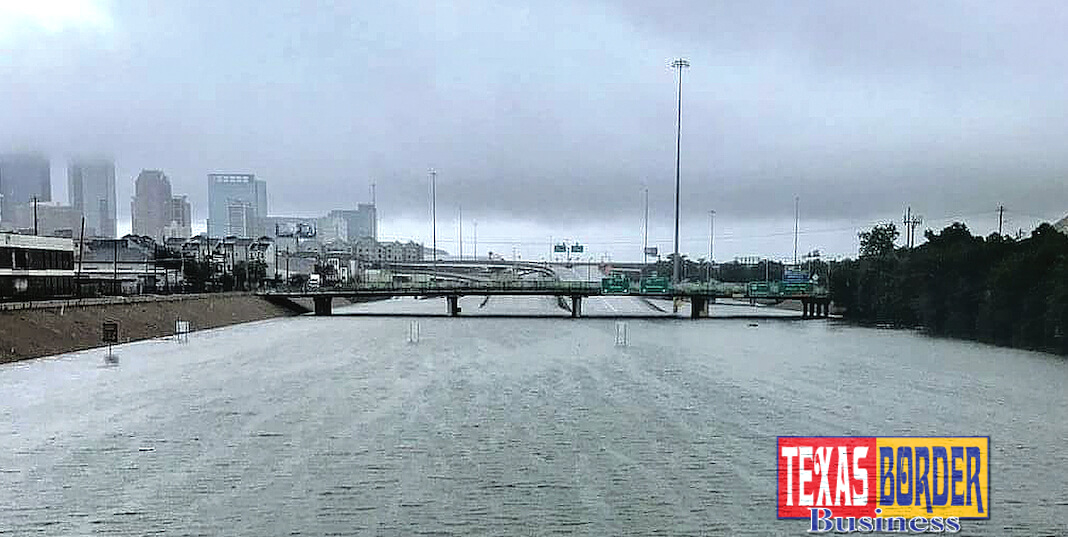
Flooding and rain topping 47 inches, 27 trillion gallons of water pounded 50 counties in southeast and lower central Texas
By Roberto Hugo Gonzalez
As originally published by Texas Border Business newsprint edition September 2017
The country’s biggest rainstorm in recorded history landed in Texas, surprising and overwhelming the smaller towns of Texas including one of the jewels of the state, Houston. Flooding and rain, topping 47 inches in some areas, pounded some 50 counties in southeastern and lower central Texas. The area includes more than 300 towns and smaller cities with a combined population of around 11 million people. They were met with the storm’s punishing force resulting in 70 deaths, at the time this report was being prepared.
For years, I have asked myself why Houston keeps flooding, now after listening to Richard Fausset, a correspondent based in Atlanta and one who covers the American South for the New York Times, I was able to understand why Houston is so fragile when it comes to heavy rains.
Fausset said during an interview that Houston is built on the edge of a swampy value, and how from the very beginning Houston was made to flood. He said that the problem started for Houston almost the moment that it was founded. According to Fausset, in the late 1830’s the city was founded by a pair of brothers, two New York real estate speculators founded the city of Houston on the banks of a muddy value.
He said that it’s an extremely flat part of the world and in the path of hurricanes every year, and almost as soon as Houston was founded it suffered a major flood, that inundated every structure in the city that was just beginning. From there it suffered about 100 floods for the next century. And it has been struggling from its very inception to deal with the bad hands that geography and fate have dealt it.
Nevertheless, even though Houston was built on a swamp, the city is fascinating and has been an example of progress, always booming, and a great place to do business. Fausset said that after the second World War massive growth registered in the 1950’s and particularly the 1960’s, which just kept coming.
It can be said that Houston has everything, it’s a port town, it’s an arts and cultural hub, and a powerful banking center. “But at its core,” Fausset said, “It’s an oil and gas town. And it’s that petrochemical industry that has been crucial to its growth for many, many years.”
He also mentioned that there’s been a number of urban theorists who’ve looked to Houston as a real model for the way a city should work. “Developers kind of run the place and there’s not much tolerance for regulation in a way that you find along the coasts or in a place like California,” Fausset said.
Just recently, on Memorial Day of 2015 Houston suffered a very bad flood. The next year what was called the Tax Day flood in April 2016, there was another devastating flood.
Even with catastrophic flooding, Harris County of which Houston is a part, has been the fastest growing county in the United States for the last nine years. The U.S. Census Bureau says Houston, Harris County led the nation by adding more than 90,000 people.
Fausset pointed out that people who lived in greater Houston had been receiving signals that something like this might happen for a few years. The city has for the last few years been trying to figure out what it’s done wrong.
He noted that after World War II in the 1950’s and 60’s, was the beginning of serious urban and suburban growth. Two of the many bayous that crisscross greater Houston were channelized. They were turned into massive concrete culverts at the time Houstonians thought that this would help with the drainage flow. Consequently, there was robust building along their banks and all around.
But, by the 1980’s a number of other bad storm events led people to realize that they didn’t know what they were doing, and that the system they had built just wasn’t working. The development had paved over the wetlands and the prairies, and they began to fear that they were making the problem worse.
Plenty of blame went around, and the same question arises all the time, why does Houston keep flooding? Today, it’s clear that most of the citizens know that one of the problems is right beneath their feet.
Fausset is a journalist that knows his business. He noted that one of the areas where Houston is having development is an area on the north-western flank of greater Houston known as the Katy Prairie.
The ironic part of this is that, once upon a time, Katy a city in the U.S. state of Texas, within the Houston-Katy-Woodlands-Sugar Land metropolitan area had been a long grass prairie that had absorbed a lot of the rainwater from a major event like this. These days it’s full of strip malls, and schools, and convenient stores and malls.
This particular area has had a tremendous growth, multimillion dollar convention center, unbelievable economic boom, and land is abundant. Because of the tremendous growth, the water that used to pool up in the grasslands now has nowhere to go. Now it’s easy to understand what happens when it rains abundantly and it is exactly what most everyone saw on TV after Hurricane Harvey.
Houstonians are beginning to notice that living in a concrete jungle will always be a no break from relentless storms and becomes a nightmare scenario when Mother Nature turns nasty. And when the rain falls it has nowhere to go except into the neighborhood streets and people’s homes.
“Wetlands and prairie lands are really important.” Fausset continued, “They’re nature’s way of absorbing floodwaters. They allow the water to percolate and filter down into the soil as opposed to just running off the way they would if they hit a Walmart parking lot. And they also serve to delay the movement of water in some cases. So, the more concrete you pour, the more you have to deal with fast moving water, so every bit of this kind of open land that is taken away potentially causes a lot more problems down the line.”
He also said that Houston does not have zoning ordinances the way most cities do. He added that one of the hallmarks of Houston life within the city is this sort of block that has the strip joint next to the Baptist Church, next to the quickie mart, so this idea that Houston is not zoned is relevant to the disaster unfolding, and that it reflects a kind of laissez faire (letting things take their own course, without interfering) and libertarian streak in Texas consciousness.
The other fact is, he said, “There’s this patchwork of town governments and city governments and county governments. Flood water doesn’t care what municipality you live in. So, you can have a poorly-planned neighborhood just ten miles from you that may be the reason why your house in the city of Houston is flooding, and there’s very little you can do about it.”
Fausset added that the problem is that Houston’s success in so many ways is based on the fact that it’s just decided to go and grow limitlessly. He said that people in the Houston area have been raising alarm bells for many, especially as the surface of the oceans has been warming and potentially creating much stronger, much wetter, much more powerful, and much more damaging storms. That means you can buy a house for very little money. This has really been one of the main reasons why it’s been so difficult to put a brake on all the construction.
The question is, who is responsible? To what Fausset said, “The debate has been very vigorous in Houston. The alarm bells have been rung by all kinds of people, by hydrologists, by urban planners, by environmentalists. Now, often by people living in neighborhoods that weren’t flooding just three or four years ago and are now flooding over and over and over again.”
We can ask this question over and over again, who is responsible? Is the problem with building and planning, or the developers that have power over a city that knows no boundaries to keep growing?













